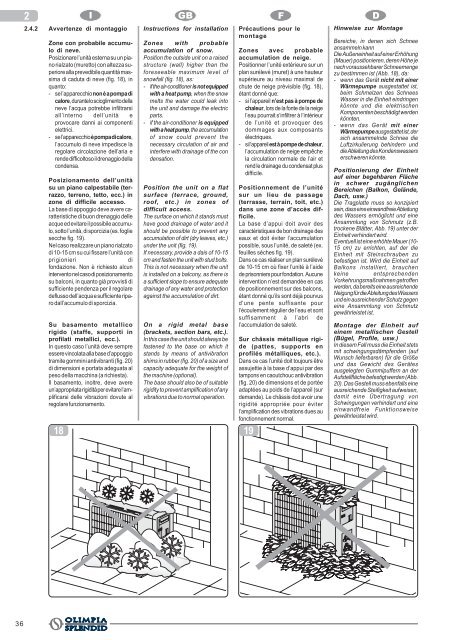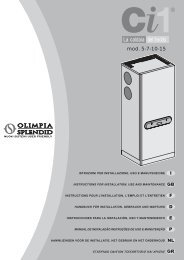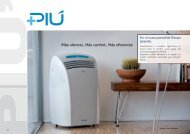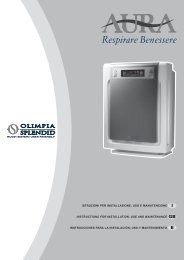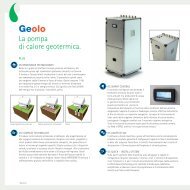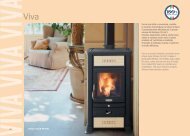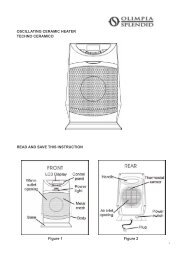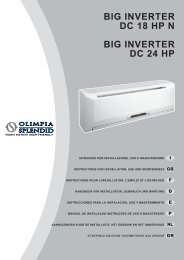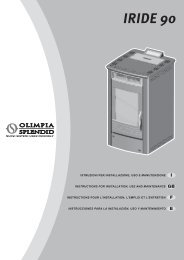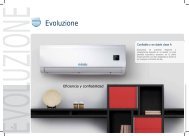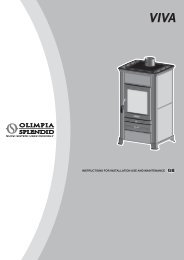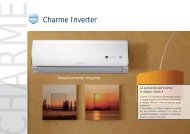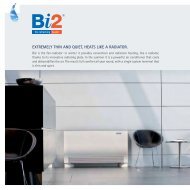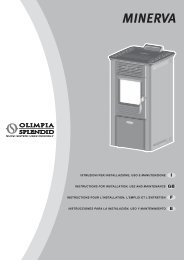manuale DIFFUSIONE BIG.pmd - Olimpia Splendid
manuale DIFFUSIONE BIG.pmd - Olimpia Splendid
manuale DIFFUSIONE BIG.pmd - Olimpia Splendid
Create successful ePaper yourself
Turn your PDF publications into a flip-book with our unique Google optimized e-Paper software.
12<br />
2.4.2<br />
Avvertenze di montaggio<br />
I GB F D<br />
Zone con probabile accumulo<br />
di neve.<br />
Posizionare l’unità esterna su un piano<br />
rialzato (muretto) con altezza superiore<br />
alla prevedibile quantità massima<br />
di caduta di neve (fig. 18), in<br />
quanto:<br />
- se l’apparecchio non è a pompa di<br />
calore, durante lo scioglimento della<br />
neve l’acqua potrebbe infiltrarsi<br />
all’interno dell’unità e<br />
provocare danni ai componenti<br />
elettrici.<br />
- se l’apparecchio è pompa di calore,<br />
l’accumulo di neve impedisce la<br />
regolare circolazione dell’aria e<br />
rende difficoltoso il drenaggio della<br />
condensa.<br />
Posizionamento dell’unità<br />
su un piano calpestabile (terrazzo,<br />
terreno, tetto, ecc.) in<br />
zone di difficile accesso.<br />
La base di appoggio deve avere caratteristiche<br />
di buon drenaggio delle<br />
acque ed evitare il possibile accumulo,<br />
sotto l’unità, di sporcizia (es. foglie<br />
secche fig. 19).<br />
Nel caso realizzare un piano rialzato<br />
di 10-15 cm su cui fissare l’unità con<br />
prigionieri<br />
di<br />
fondazione. Non è richiesto alcun<br />
intervento nel caso di posizionamento<br />
su balconi, in quanto già provvisti di<br />
sufficiente pendenza per il regolare<br />
deflusso dell’acqua e sufficiente riparo<br />
dall’accumulo di sporcizia.<br />
Su basamento metallico<br />
rigido (staffe, supporti in<br />
profilati metallici, ecc.).<br />
In questo caso l’unità deve sempre<br />
essere vincolata alla base d’appoggio<br />
tramite gommini antivibranti (fig. 20)<br />
di dimensioni e portata adeguata al<br />
peso della macchina (a richiesta).<br />
Il basamento, inoltre, deve avere<br />
un’appropriata rigidità per evitare l’amplificarsi<br />
delle vibrazioni dovute al<br />
regolare funzionamento.<br />
18<br />
Instructions for installation<br />
Zones with probable<br />
accumulation of snow.<br />
Position the outside unit on a raised<br />
structure (wall) higher than the<br />
foreseeable maximum level of<br />
snowfall (fig. 18), as:<br />
- if the air-conditioner is not equipped<br />
with a heat pump, when the snow<br />
melts the water could leak into<br />
the unit and damage the electric<br />
parts.<br />
- if the air-conditioner is equipped<br />
with a heat pump, the accumulation<br />
of snow could prevent the<br />
necessary circulation of air and<br />
interfere with drainage of the con<br />
densation.<br />
Position the unit on a flat<br />
surface (terrace, ground,<br />
roof, etc.) in zones of<br />
difficult access.<br />
The surface on which it stands must<br />
have good drainage of water and it<br />
should be possible to prevent any<br />
accumulation of dirt (dry leaves, etc.)<br />
under the unit (fig. 19).<br />
If necessary, provide a dais of 10-15<br />
cm and fasten the unit with stud bolts.<br />
This is not necessary when the unit<br />
is installed on a balcony, as there is<br />
a sufficient slope to ensure adequate<br />
drainage of any water and protection<br />
against the accumulation of dirt.<br />
On a rigid metal base<br />
(brackets, section bars, etc.).<br />
In this case the unit should always be<br />
fastened to the base on which it<br />
stands by means of antivibration<br />
shims in rubber (fig. 20) of a size and<br />
capacity adequate for the weight of<br />
the machine (optional).<br />
The base should also be of suitable<br />
rigidity to prevent amplification of any<br />
vibrations due to normal operation.<br />
Précautions pour le<br />
montage<br />
Zones avec probable<br />
accumulation de neige.<br />
Positionner l’unité extérieure sur un<br />
plan surélevé (muret) à une hauteur<br />
supérieure au niveau maximal de<br />
chute de neige prévisible (fig. 18),<br />
étant donné que:<br />
- si l’appareil n’est pas à pompe de<br />
chaleur, lors de la fonte de la neige<br />
l’eau pourrait s’infiltrer à l’intérieur<br />
de l’unité et provoquer des<br />
dommages aux composants<br />
électriques.<br />
- si l’appareil est à pompe de chaleur,<br />
l’accumulation de neige empêche<br />
la circulation normale de l’air et<br />
rend le drainage du condensat plus<br />
difficile.<br />
Positionnement de l’unité<br />
sur un lieu de passage<br />
(terrasse, terrain, toit, etc.)<br />
dans une zone d’accès difficile.<br />
La base d’appui doit avoir des<br />
caractéristiques de bon drainage des<br />
eaux et doit éviter l’accumulation<br />
possible, sous l’unité, de saleté (ex.<br />
feuilles sèches fig. 19).<br />
Dans ce cas réaliser un plan surélevé<br />
de 10-15 cm où fixer l’unité à l’aide<br />
de prisonniers pour fondation. Aucune<br />
intervention n’est demandée en cas<br />
de positionnement sur des balcons,<br />
étant donné qu’ils sont déjà pourvus<br />
d’une pente suffisante pour<br />
l’écoulement régulier de l’eau et sont<br />
suffisamment à l’abri de<br />
l’accumulation de saleté.<br />
Sur châssis métallique rigide<br />
(pattes, supports en<br />
profilés métalliques, etc.).<br />
Dans ce cas l’unité doit toujours être<br />
assujettie à la base d’appui par des<br />
tampons en caoutchouc antivibration<br />
(fig. 20) de dimensions et de portée<br />
adaptées au poids de l’appareil (sur<br />
demande). Le châssis doit avoir une<br />
rigidité appropriée pour éviter<br />
l’amplification des vibrations dues au<br />
fonctionnement normal.<br />
19<br />
Hinweise zur Montage<br />
Bereiche, in denen sich Schnee<br />
ansammeln kann<br />
Die Außeneinheit auf einer Erhöhung<br />
(Mauer) positionieren, deren Höhe je<br />
nach voraussehbarer Schneemenge<br />
zu bestimmen ist (Abb. 18), da:<br />
- wenn das Gerät nicht mit einer<br />
Wärmepumpe ausgestattet ist,<br />
beim Schmelzen des Schnees<br />
Wasser in die Einheit eindringen<br />
könnte und die elektrischen<br />
Komponenten beschädigt werden<br />
könnten.<br />
- wenn das Gerät mit einer<br />
Wärmepumpe ausgestattet ist, der<br />
sich ansammelnde Schnee die<br />
Luftzirkulierung behindern und<br />
die Ableitung des Kondenswassers<br />
erschweren könnte.<br />
Positionierung der Einheit<br />
auf einer begehbaren Fläche<br />
in schwer zugänglichen<br />
Bereichen (Balkon, Gelände,<br />
Dach, usw.)<br />
Die Tragplatte muss so konzipiert<br />
sein, dass eine einwandfreie Ableitung<br />
des Wassers ermöglicht und eine<br />
Ansammlung von Schmutz (z.B.<br />
trockene Blätter, Abb. 19) unter der<br />
Einheit verhindert wird.<br />
Eventuell ist eine erhöhte Mauer (10-<br />
15 cm) zu errichten, auf der die<br />
Einheit mit Steinschrauben zu<br />
befestigen ist. Wird die Einheit auf<br />
Balkons installiert, brauchen<br />
keine entsprechenden<br />
Vorkehrungsmaßnahmen getroffen<br />
werden, da bereits eine ausreichende<br />
Neigung für die Ableitung des Wassers<br />
und ein ausreichender Schutz gegen<br />
eine Ansammlung von Schmutz<br />
gewährleistet ist.<br />
Montage der Einheit auf<br />
einem metallischen Gestell<br />
(Bügel, Profile, usw.)<br />
In diesem Fall muss die Einheit stets<br />
mit schwingungsdämpfenden (auf<br />
Wunsch lieferbaren) für die Größe<br />
und das Gewicht des Gerätes<br />
ausgelegten Gummipuffern an der<br />
Aufstellfläche befestigt werden (Abb.<br />
20). Das Gestell muss ebenfalls eine<br />
ausreichende Steifigkeit aufweisen,<br />
damit eine Übertragung von<br />
Schwingungen verhindert und eine<br />
einwandfreie Funktionsweise<br />
gewährleistet wird.<br />
36


